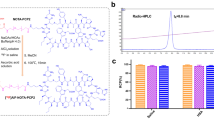Abstract
The formation and persistence of platinum-DNA adducts were studied with immuno(cyto)chemical methods in male and female Sprague-Dawley rats treated with a single i.p. dose of carboplatin. Linear dose-effect curves were observed for kidney and liver with an immunocytochemical assay using NKI-A59 antiserum that recognizes intrastrand cross-links. With this method, no staining of the nuclei due to platinum-DNA damage could be observed in the spleen, testis, uterus, or ovary after administration of up to 80 mg/kg carboplatin. A homogeneous staining of the nuclei in the liver was observed. The nuclear staining in the kidney was somewhat more intense but less homogeneous, with small groups of intensely stained nuclei occasionally being seen in the outer cortex. An approximately 15 to 20-times lower dose of cisplatin than of carboplatin was needed to reach equal staining levels in the liver and kidney. Plateau staining levels in both tissues were reached at between approximately 8 and 48 h after administration of the carboplatin. This was followed by a significant reduction in the kidney samples, whereas the staining levels in the liver section seemed to be more persistent. No major difference was observed between male and female rats in the formation and removal of DNA damage in these tissues. The levels of the various DNA adducts were measured with a competitive ELISA in liver, kidney, spleen, testis, and combined ovary/uterus samples collected at 8 and 48 h after carboplatin administration. At both 8 and 48 h, the highest platination levels were observed in the kidney, followed—in decreasing order—by the liver, combined uterus and ovary samples, spleen, and testis. At 8 h after administration of carboplatin, the relative occurrence of the bifunctional adducts Pt-GG (34%), Pt-AG (27%), and G-Pt-G (32%), was similar in all tissues. The same held for the monoadducts that amounted to about 7% of the total DNA platination. These data indicate that in the first few hours after carboplatin treatment, no preference for the formation of Pt-GG adducts was observed, which confirms our earlier observations obtained with cultured cells. When the total DNA-platination levels (calculated from the sum of the adducts) seen at 8 and 48 h after treatment were compared, a substantial decrease in DNA platination was observed in the kidney (37%), liver (30%) and ovary/uterus (39%), whereas the repair levels in the testis (9%) and, probably, the spleen (18%) were substantially lower. In all tissues studied, only the relative occurrence of the Pt-GG adducts increased between 8 and 48 h, and as a result, at 48 h, after carboplatin administration the Pt-GG adduct was the major adduct persisting in the DNA samples.
Similar content being viewed by others
Author information
Authors and Affiliations
Additional information
Received: 31 May 1995/Accepted: 19 October 1995
Rights and permissions
About this article
Cite this article
Blommaert, F., Michael, C., van Dijk-Knijnenburg, H. et al. The formation and persistence of carboplatin-DNA adducts in rats. Cancer Chemother Pharmacol 38, 273–280 (1996). https://doi.org/10.1007/s002800050482
Issue Date:
DOI: https://doi.org/10.1007/s002800050482




